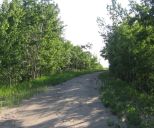|
Advocate View (Editorial)
On the trail of a worthy plan
reprinted from the Red Deer
Advocate (Greg Neiman), Sept. 9, 2005
Every community needs people who can take a good idea, hold on to it
and patiently work it into completion. People like Bob Johnstone,
president of the Central Alberta Region Trail Society.
He's bought into the idea that a national network of cycle and
hiking trails would be a great legacy, and he's willing to invest an
awful lot of his time to help bring local sections of that network
into existence.
Red Deer's trail system added 29 km to that network last June, and a
trail marker in Bower Ponds will be officially unveiled on Saturday.
Dedicating already-existing trails into the Trans Canada Trail
system is obviously a good idea. But the TCT -- the longest
cycling/hiking route in the world at 18,000 km -- won't be a reality
until a whole lot of new trail is built.
Although Alberta already has about 600 km of the trail completed, we
have a long way to go, because the east-west route across Canada
makes an intersection in Alberta with the route heading north into
the Yukon.
That means we get the nation's largest provincial portion of the
trail, which -- as Johnstone could surely tell you -- is both a
blessing and a challenge.
It's a blessing because Alberta will have access to one of the
world's top new tourism draws of the millennium (about 62 per cent
of our section of the trail has been completed), and because
Red Deer will be almost in the centre of it.
A recent Price Waterhouse study done in Ontario gives an indication
of how big a deal this idea can be. They concluded that once
Ontario's part of the TCT is complete, it will add about $2.4
billion in value-added income to the province's economy. As much as
42,000 direct and indirect jobs will be added to the economy, fueled
by the money that people spend using the trails.
British Columbia needed no such study to conclude that it would be
worth $13.4 million to rebuild or refurbish 14 trestle bridges that
were destroyed or damaged in the forest fires of 2003.
The Kettle Valley Trail, that runs 450 km over old railway beds (and
the trestle bridges in the spectacular Myra Valley canyon), is a key
part of Central B.C.'s tourism plan.
In fact, they are spending even more money to expand the trail to
700 km, linking other existing trails and 18 communities in their
Spirit of 2010 project.
Alberta's recently-completed Iron Horse Trail runs for 300 km, much
of it on old rail lines and is designed for four-season use. It now
links Waskatenau (and from there, the Saskatchewan portion), to Cold
Lake and beyond, to be linked with Alberta's capital region of the
CTC. It's already proving to be a huge tourism booster.
Even though the experience of people living along trails shows that
the trails produce far fewer problems than benefits, getting
stakeholder support (which includes local landowners) is proving to
be a slow process.
Another roadblock to the easy linking of communities (and their
local trail networks) is the policy of Alberta Transport not to
allow trail development along highways to link communities.
A media spokesperson for Alberta Transportation and Infrastructure
maintained the policy is to address safety concerns.
But if there's no trail along the road allowance of a highway, a
cyclist or hiker would have to travel the highway itself. That can't
improve safety.
It certainly can't be because of the cost, because local trail
committees actually raise money for trail construction and upkeep --
and the trails more than pay for themselves in increased tourist
trade anyway.
Just ask the merchants at Bentley, who prosper each summer from the
roadside trail linking the Aspen Beach campground on Gull Lake to
the town.
Even so, some local highway routes are fabulous bike routes all on
their own.
One example: Hwy 951 north of Leslieville is one of the most
beautiful country rides you could find anywhere, and it links
wonderfully on a circle route on Hwy 51 east to Bentley or west and
south back to Rocky Mountain House.
There are many other such routes, that beg for a linked trail
network. Consider the route following the Boomtown Trail southeast
of Red Deer.
How much more successful could that tourism effort be if the
provincial government allowed some of the communities on it to be
linked on cycle trails just off the highways?
These kinds of local roadblocks might be enough to make some
dedicated volunteers just give up and stay home.
But people like Bob Johnstone just keep on working. That's why
communities need them.
Central Alberta Regional Trails Society
News articles related to regional trail development including
rail-trails:
Commentary: Preservation Opportunity Not to be
Lost (Innisfail Province & Red
Deer Advocate June 2015)
News article: Red Deer County seeks partners
to afford bridge access
(Mountain View Gazette Apr.2012)
News article: County council looks at bridge
as tourist attraction
(Red Deer Advocate April 2012)
News article: Plans for Mintlaw Bridge waiting
on public feedback
(Mountain View Gazette Feb.2012)
News article: City council adopts river valley
plan
(Red Deer Express July 2010)
News article: Building trails to paradise
(Red Deer Advocate March 2009)
News article: Clearwater County calls on
province for advice about trail
(Red Deer Advocate April 2008)
|

